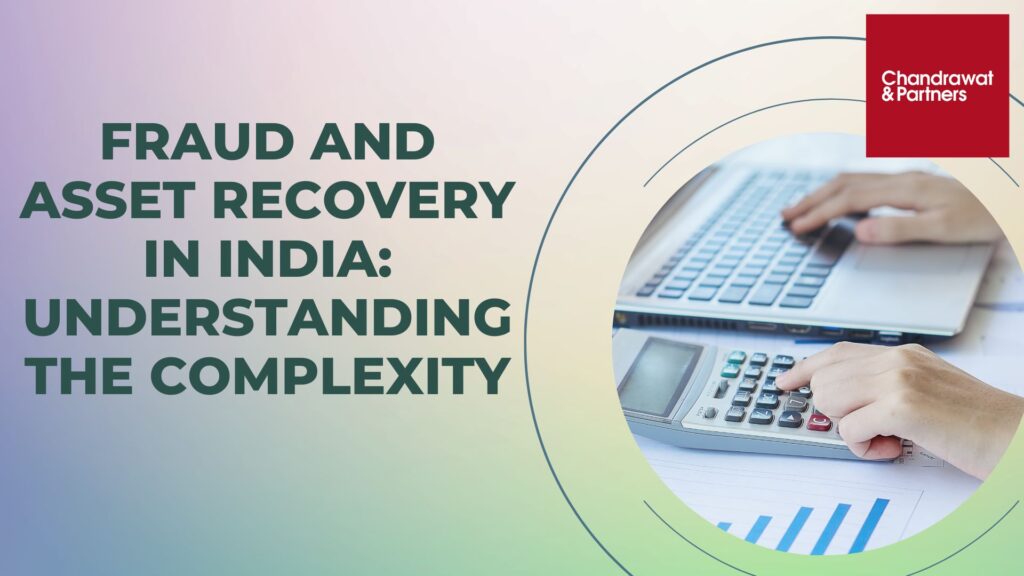Fraud and asset recovery in India: Understanding the complexity
Introduction
Fraud has emerged as a significant concern in India, posing challenges for individuals, businesses, and the overall economy. Various types of fraud have inflicted substantial losses on victims, creating an urgent need for effective asset recovery mechanisms to combat these crimes. Understanding the complexity of fraud and asset recovery in India requires an exploration of the factors contributing to the rise of fraudulent activities, the legal framework in place, and the challenges faced in recovering stolen assets. India has witnessed a surge in fraud cases in recent years, which can be attributed to several factors.
Rapid economic growth and the proliferation of digital technology has created new opportunities for fraudsters to exploit vulnerabilities in financial systems. Asset recovery is a critical component of the fight against fraud. Recovering stolen assets not only serves as a deterrent but also helps compensate victims and restore confidence in the financial system. Fraud in India encompasses a wide range of activities, each with its own intricacies. Some common types of fraud include financial fraud, bank fraud, securities fraud, insurance fraud, tax evasion, money laundering, and cyber fraud.
Factors contributing to fraud
Several factors contribute to the prevalence of fraud in India. One key factor is the existence of information asymmetry, where individuals or entities exploit the lack of information or knowledge among victims for personal gain. Additionally, weak internal controls, inadequate risk management systems, lack of transparency, and a culture of corruption all play their roles in facilitating fraudulent activities. Rapid technological advancements and the increased use of digital platforms have also created new opportunities for fraudsters to exploit vulnerabilities and carry out cyber fraud.
Legal and regulatory framework for asset recovery
India has implemented various laws and regulations to combat fraud and enable asset recovery. The Prevention of Money Laundering Act (“PMLA”) and the Benami Transactions (Prohibition) Act are two crucial le. The PMLA focuses on money laundering offenses and provides authorities with extensive powers to trace, seize, and confiscate proceeds of crime. The Benami Transactions Act aims to curb transactions where property is held by one person but financed by another, helping to uncover concealed assets.
Section 3 of the PMLA provides an explanation to clarify certain aspects, stating that a person will be considered guilty of money laundering if they are found to have directly or indirectly attempted to engage in or been involved in one or more of the activities related to the proceeds of a crime. Section 4 of the said Act deals with the punishment for the offense of money laundering. In simple terms, it states that anyone found guilty of money laundering shall be subject to rigorous imprisonment for a minimum term of three years, which can extend up to seven years along with fine.
Investigating fraud and tracing assets
The investigation of fraud and the tracing of assets involve a systematic and multi-faceted approach, combining the efforts of various entities, including law enforcement agencies, financial institutions, forensic experts, and regulatory bodies. While the specific procedures may vary depending on the nature and complexity of the case, here are some common steps involved in the investigation and asset tracing process:
- Complaint and preliminary examination: The investigation typically begins with a complaint lodged with the relevant law enforcement agency or regulatory body. Upon receiving the complaint, a preliminary examination is conducted to determine the credibility and merit of the allegations. This may involve collecting initial information, reviewing documents, and conducting initial interviews.
- First Information Report (“FIR”) and jurisdiction: If the complaint discloses a cognizable offense, an FIR is registered with the police. The FIR outlines the details of the alleged offense and identifies the individuals or entities involved. The jurisdiction of the investigating agency is determined based on the location of the offense and the relevant laws governing the case.
- Investigation planning and evidence gathering: Once the FIR is registered, the investigating agency assigns a team of officers, determines the scope of the investigation, and establishes timelines and priorities. The investigating agency employs various methods to gather evidence. Covert operations, including surveillance and wiretapping, may also be utilized with proper legal authorization.
- Forensic accounting and data analytics: Forensic accountants play a crucial role in fraud investigations. They analyse financial records, identify discrepancies, and trace the flow of funds. Data analytics techniques are also employed to detect patterns, anomalies, and suspicious transactions, which can aid in identifying assets and establishing links between different entities involved in the fraud.
- Freezing and seizing assets: To prevent fraudsters from dissipating or transferring assets, investigating agencies may seek court orders to freeze and seize assets identified as proceeds of the crime. These assets can include bank accounts, properties, vehicles, or other valuable assets. The freezing and seizure of assets require coordination between the investigating agency, financial institutions, and relevant authorities.
- Adjudication and prosecution: Once the investigation is complete, the investigating agency presents the gathered evidence before the appropriate court or adjudicating authority. The prosecution presents its case against the accused, highlighting the evidence of fraud and asset misappropriation. The court evaluates the evidence and delivers its judgment, which may involve conviction, acquittal, or other legal remedies, including the confiscation of assets.
- Asset recovery: Asset recovery is a critical aspect of combating fraud. After a conviction or court order, efforts are made to recover and repatriate the seized or frozen assets. This involves selling the assets and distributing the proceeds to compensate the victims or restore the funds to their rightful owners. The recovered assets may also be used to compensate the state for the expenses incurred during the investigation and prosecution.
Challenges in asset recovery
While significant progress has been made in the field of asset recovery in India, several challenges persist. One major challenge is the lack of coordination among various agencies involved in asset recovery, leading to delays and inefficiencies. Limited resources, including manpower and technology, also hinder the effectiveness of asset recovery efforts. Additionally, the legal process can be protracted, and fraudsters may exploit legal loopholes or flee the country, making it difficult to recover assets. There may be a lack of awareness among the general public and even within financial institutions regarding the importance of reporting suspicious activities and fraudulent transactions. This hampers the early detection and timely reporting of fraud, impeding asset recovery efforts.
In a nutshell
In a nutshell it can be said that, fraud poses a significant challenge to India’s economic growth and stability. However, with the implementation of robust legal and regulatory frameworks, improved investigative techniques, and enhanced international cooperation, asset recovery efforts have gained momentum. As India continues to refine its asset recovery mechanisms, it is crucial to prioritize coordination among agencies, invest in technology and manpower, and streamline the legal process to ensure the swift and efficient recovery of stolen assets.
For more information or queries, please email us at
[email protected]





